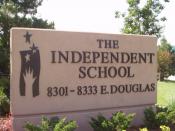Theresa Hartman November 7, 2001 Presentation EDU 4565 "Your Schools, Your Money" Former Governor Tom Ridge believed in empowering taxpayers with useful information to help them make informed decisions about their public schools and to better hold schools accountable to the students, parents and communities they serve. The 2000-01 budget includes $2.5 million to fund the development of an independent school-evaluation tool that analyzes schools? academic and financial data and provide impartial and understandable findings on financial and academic performance. This tool, which will be developed by Standard and Poor?s using public data and information, will enable taxpayers to compare and evaluate their schools on a local, regional, and statewide basis in the attempt to help school leaders and educators make curricular and management decisions based on its findings. In addition, former Governor Ridge has invested in two other programs to hold schools accountable for the money they spend. Ridge has invested $1.45
million in the "Your Schools, Your Money" project to help track down how much money is spent in each school building by grade level in elementary schools and by subject matter in secondary schools. "Your Schools, Your Money" uses web-based technology to provide easily understandable and consistent financial information for taxpayers and school administrators. This tool allows taxpayers to access financial information of their school through the web. It also allows all school administrators to better analyze and track the financial data collected by this tool. Hopefully, "Your Schools, Your Money" will help educators, administrators, parents, and taxpayers to better their schools.
For many reasons, from local to state to national levels, the desire to "demystify" school finance and communicate information in a user-friendly format has grown over the last several years. It is important to remember that citizens have invested a great deal of their resources and money into our school systems, and they wish to see how their money is spent and how their resources are used. To tackle the task of compiling financial data into a "usable" tool, the Pennsylvania Department of Education enlisted more than 50 volunteer local education agencies (consisting of school districts, intermediate units, and vocational technical schools) to work collaboratively over a two-year pilot program to develop a strategy to address this new informational reporting. In addition, the pilot participants reviewed the current accounting manual and suggested several revisions to expand and improve it. In this way, "Your Schools, Your Money" provides a more comprehensive approach to budgeting.
Within the legal and philosophical framework of the Pennsylvania School Code there exists specific rights and responsibilities to the administration of any given district. Schools choose and use various products and technologies to process their accounting, administrative and student information; therefore, they should have the ability to build upon their already existing frameworks. To honor that philosophy, this project builds upon currently existing procedures at each school district. However, common components with consistent definitions across school districts must be established in order to improve financial analysis across the Commonwealth. My presentation will begin to highlight what is expected of school districts in the upcoming two years in terms of using "Your Schools, Your Money" in the least burdensome and most effective way.
Both the first year and second year implementation components include district level and school operational components. Detailed documents found on the Pennsylvania Department of Education website can further explain the more technical aspects of these components and the proper way to record them. Administrative Support Costs, Special Education Instructional Costs, Extracurricular Activities, Transportation Costs, Total Outstanding Long Term Debt, Revenues by Source, and Total Funds Available are all district level areas to be reported in a more standardized manner. Classroom Instructional Costs, Instructional Student Support Costs, and Facilities and Maintenance Costs are all school operation level components to be addressed in year one. The second year will address Special Education Non-Instructional Costs, Food Service Costs, Professional Development Costs, Technology Costs, and Grade Level and Subject Matter divisions. This data may only be submitted to the Department from December 1-15. It is important for school districts to continually check with the Department for any changes in format and recording. As the program begins to take more form across the state, more changes may occur to make "Your Schools, Your Money" both an informational and beneficial tool for all.





